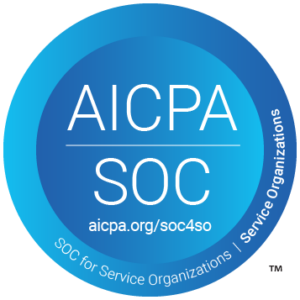Most leaders in higher education agree that improving student engagement is essential to driving positive outcomes for both their school and their students. When it comes to defining and measuring student engagement, though, there are often more questions than answers.
That’s understandable, because student engagement can look very different from one institution to the next. This one-size-doesn’t-fit-all approach to engagement is actually a good thing! The way you define student engagement likely depends on the demographics and backgrounds of your student population, your unique success objectives, and a diverse array of factors specific to your institution.
We wanted to further explore the various perspectives on student engagement, so Mainstay surveyed 50 of our higher education partners this summer. Here’s what we learned from the results — and how you can use these findings to advance the conversation around student engagement at your own institution.
73.9% believe improving student engagement is extremely important
On a scale from 1 (not at all important) to 10 (extremely important), the average rating for the importance of improving student engagement was 9.4. No respondent scored it lower than a 5, and the vast majority (73.9%) rated it a 10.
It’s evident that engagement remains a high priority for colleges and universities. The individuals we surveyed use Mainstay to manage their student engagement activities, so they understand the value of using a platform that actively builds meaningful relationships with students.
Key student engagement factors vary greatly from school to school
There was a wide variety of responses when we asked people to identify the key factors that contribute to student engagement. What was interesting was that almost every response fit into one of the four building blocks of student engagement we outlined in our “Defining student engagement” white paper:
- Interaction
- Involvement
- Quality of effort
- Intentionality
Here’s some additional context about the responses we saw, and how they aligned with the building blocks of student engagement.
Interaction
Nearly 50% of respondents cited interactions with either peers, faculty, or staff as indicators that a student is engaged. Based on this data, our respondents feel strongly that the interactions students have (or don’t have) can indicate whether or not they’re engaged. This word cloud demonstrates some of the most popular answers, with the largest sizes representing the most frequent responses.
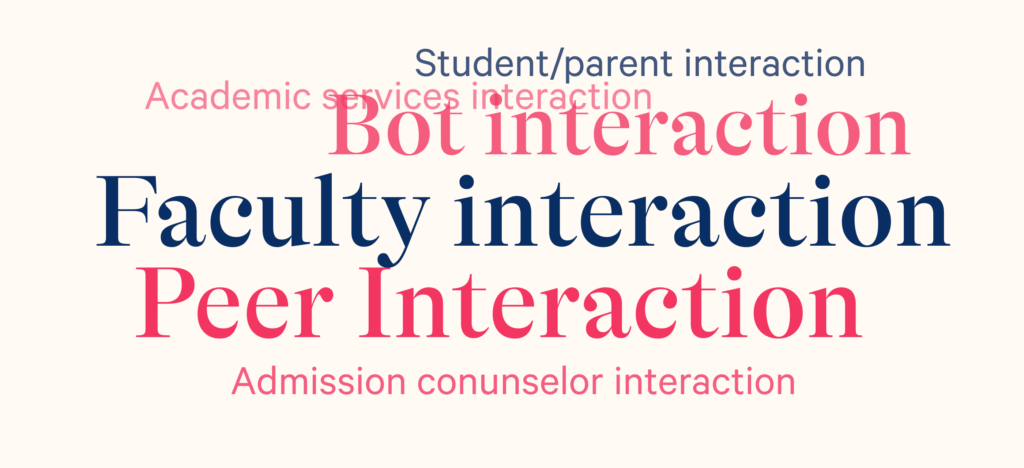
Interaction with peers, instructors, counselors, and coaches is crucial to student success. Research also suggests that when compassionate, two-way support is delivered through technology, it can be just as effective as in-person engagement. Behaviorally intelligent chatbots that provide personalized, conversational engagement can effectively expand the support network an institution offers its students.
Involvement
It’s no surprise that participation in academic life was mentioned several times as an important indicator of student engagement. After all, the earliest definitions of student engagement considered academic success to be one of the most important pieces of the puzzle.
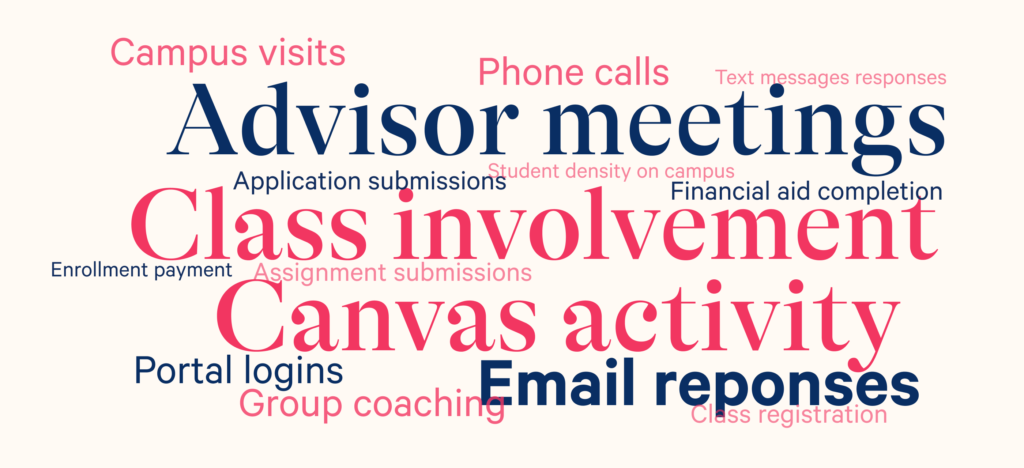
Many respondents also measure engagement by tangible actions and tasks, though. Submitting an application, enrolling, or making progress towards degree completion were well represented in the survey responses. This indicates that schools have an expanded view of what student engagement means to include essential non-academic activities, as well.
Quality of effort
The amount of time students invest and the depth of their engagement was also important to respondents. Visiting a counselor, organizing on-campus activities, or leading a group coaching session were some of the activities that fall under this category.
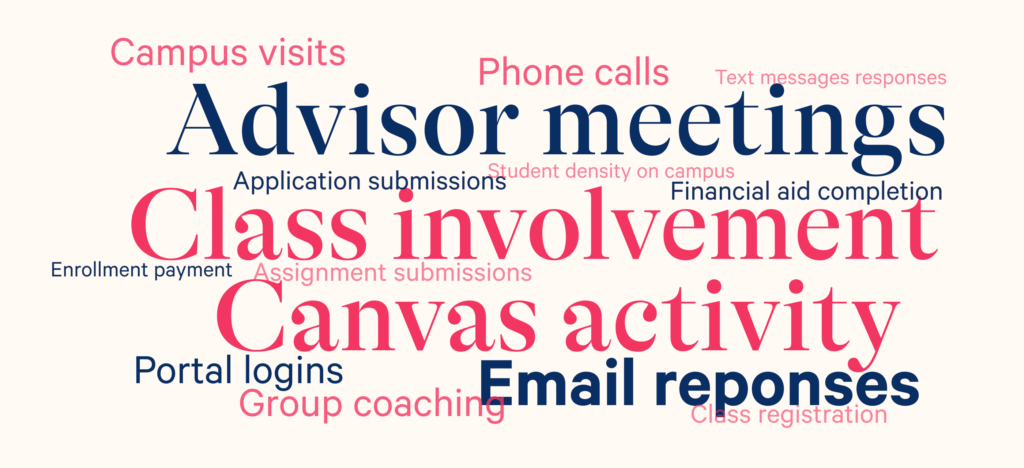
This is an interesting finding because it points to the ways students behave when they are truly engaged with their college experience. It also acknowledges that different students demonstrate engagement differently. That’s important to keep in mind when you think of the makeup of your institution and how you define student engagement at your school.
Intentionality
Fostering an open, inclusive environment that encourages organic interactions can contribute to a students’ overall sense of belonging in the campus community. According to respondents, participation in activities and events outside of the classroom can indicate that students are engaged with the overall academic experience.
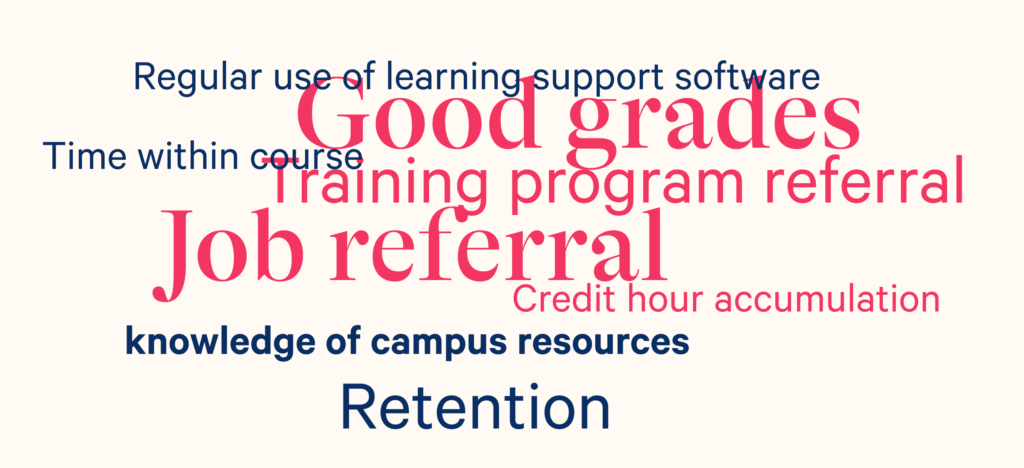
The connection between engagement and a sense of belonging isn’t to be underestimated. A student’s sense of belonging on campus directly affects their feelings of acceptance, respect, value, and happiness. Involvement in activities that foster a sense of belonging can be a key predictor of long-term student success.
Measuring student engagement
Each student has unique goals and challenges that define their academic experience. Higher education leaders are tasked with tracking and improving student engagement across large cohorts of students — which is not a light lift.
Many institutions don’t consistently track student engagement
To better understand student engagement, it’s crucial to define, measure, and track key metrics. 66% of respondents don’t currently track student engagement at their institution. One reason for this may be the complexity involved in identifying the most important aspects of student engagement. After all, it can be hard to measure something until you define what it means.
Systems for tracking student engagement vary by institution
Among the one-third of institutions that are actively tracking student engagement, we saw a variety of different approaches. Most respondents use an institution-specific tool (43.8%) or a commercial survey tool (37.5%) — and the timing of these measurements ranged between once a month and once per semester.
Institutions are seeking ways to measure student engagement effectively
The majority of respondents (70.2%) were interested in a new way to measure student engagement. They’re looking to gain a better understanding of how to engage students, and how to determine which engagement activities lead to the best student success outcomes.
Creating a definition of student engagement at your school will help you develop a sense of what you should measure, how frequently you should do it, and the best way to track these metrics over time.
Start building your own student engagement definition
Our survey findings indicate that across the board, a deeper understanding of what defines engagement, and how to measure it continuously, are critical to success. Check out our free guide, “How to define student engagement at your college,” to get started. It lays out the actionable steps you can take to identify the most important engagement factors for your school, navigate challenges along the way, and advance your institution’s approach to student engagement.


